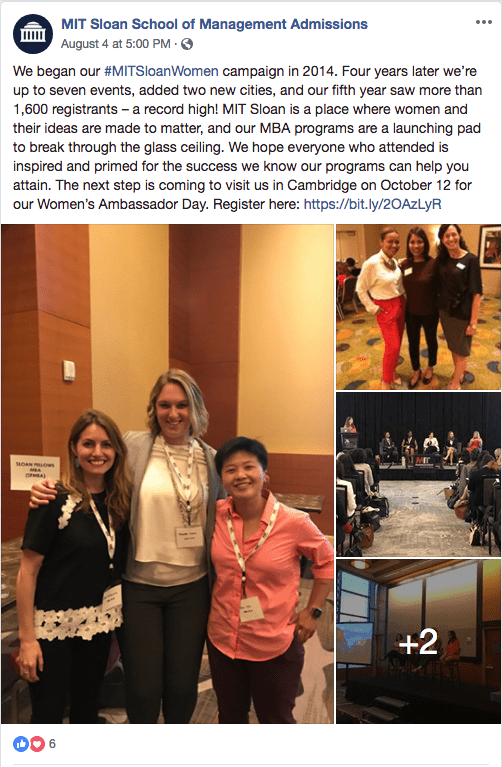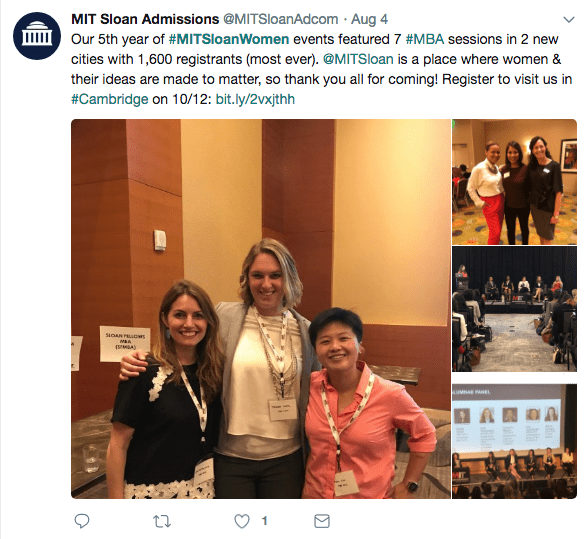Applications Down 4.5 Percent at HBS, But Applicant Quality Remains High

The release of the Harvard Business School (HBS) Class of 2020 profile statistics last week revealed that the Boston school—like many of its U.S. peers—saw a decrease in overall application volume, but median GMAT score and GPA remained unchanged from the prior year at 730 and 3.71 respectively. The admit rate, 11 percent, was also unchanged year over year. So though he was working from a smaller pool of 9,886 applicants (down from 10,351 last year), Managing Director of Admissions and Financial Aid Chad Losee did not sacrifice on quality.
Harvard Business School Application Slips for Class of 2020
HBS is one of many leading U.S. business schools to see application volume drop off in this most recent application cycle. A strong economy paired with concerns among international applicants about potential student and work visa challenges made for even more dramatic declines at schools like UNC Kenan-Flagler and Georgetown’s McDonough School, which reported double-digit drops of 18.3 and 16.2 percent respectively. Yield at HBS–which is to say the percentage of admitted students who chose to enroll–slipped from 91 to 90 percent. Still, HBS remains far and away the leader in this statistic.

Applications are down 4.5 percent at HBS, but declines across other U.S. MBA programs was much more apparent.
At HBS, the 4.5 percent application volume decline was spread between both international and domestic applicants. International students make up slightly more of the HBS class this year, 37 percent compared to 35 percent last year. They hail from 69 countries as compared to 70 for the Class of 2019.
Another interesting development is the increase in GRE takers among admitted students. A record-setting 15 percent of the incoming class got there on the strength of their GRE scores, up from 12 percent last year. It’s only in the past couple of years that schools have begun to disclose the percentages of students who submit GRE scores in lieu of GMAT scores, which used to be the gold standard. But at HBS and elsewhere, a growing number of applicants seem to be taking schools at their word that they are indeed test agnostic.
There were not a lot of major shifts elsewhere in the statistics for the newest HBS class. The percentage of women is down by one point, slipping from 42 to 41 percent. U.S. ethnic minorities remained constant year over year at 26 percent of the class. The average age also remains unchanged at 27.
Applicants from Private Equity, Tech, Increase
In terms of prior work experience, there were again few shifts from the prior year. Slightly more students came in from private equity/venture capital (16 percent, compared to 15 percent last year), tech (also 16 percent, up from 15), and government/non-profit (7 to 8 percent). These upticks correlate with small declines in students from industrial/heavy manufacturing and other services. Military veterans make up 5 percent of the Class of 2020, on par with the Class of 2019.
And in terms of what students in this year’s entering class studied as undergraduates, again HBS showed little fluctuation. Economics/business majors make up the largest portion—46 percent, up from 45 percent last year. STEM undergrads also increased one percentage point, from 36 to 37 percent. Humanities/social science undergraduates made up just 17 percent of the class, down from 19 percent last year.
To view HBS’s complete Class of 2020 profile, click here.
This article has been edited and republished with permissions from our sister site, Clear Admit.
Analyzing Credit, Bargain Hunting and Harvard, and More – Boston News

Let’s explore some of the most interesting stories that have emerged from Boston business schools this week.
What an MIT Professor Learned Analyzing 1 Million Credit Card Offers – MIT Sloan Newsroom
MIT Sloan Professor of Finance Antoinette Schoar used her appearance on Sloan’s “Data Made to Matter” podcast to discuss what analyzing one million credit card offers revealed.
“What we seemed to find in our study is that the [credit card] offers that are offered to less educated people rely in their pricing much more on these additional fees. Late fees, over limit fees, maybe default APRs that switch on once you’ve had a default,” she says on the podcast.
Schoar adds, “While people that are more educated, their cards seem to rely much more on the quite straightforward features, like they are paying an annual fee, and they’re paying an interest rate, but they are relying much less on these late fees and over limit fees.”
She also offers this takeaway for consumers:
“The more companies can model our behavioral biases, the more they can use them in extracting rents from us or catching us in moments when we’re inattentive or when we are not necessarily focused enough on choosing the right credit card, the right mortgage, or any of these products.”
You can read the full article here.
Bargain Hunters Beware: A Store’s ‘Original Price’ Might Not Be After All – Harvard Business Week
In a new working paper, Donald Ngwe, a Harvard Business School Assistant Professor, found that the “original price” many retail stores advertise in relation to an item’s hot bargain rate is often completely made up. In fact, the practice is much “more common than shoppers might realize.”
Ngwe says, “They never even tried to sell the product at that price. Consumers could never have bought that product at that price even if they tried.”
On Amazon, for instance, he notes that almost every item has a “struck-out price, but if you look at the policy behind that price, it’s incredibly vague. This makes me think that the fake prices are working to mislead the customers who know the brand the least, and who have the least information about the brand, into making a decision they would not have made otherwise.”
Ngwe’s research found that if customers “were given verifiably fake prices,” it actually does not change people’s “evaluation of quality” since we have gotten so used to the practice.
He concludes, “My results show that customers don’t see through the ruse. Even in outlet stores where they might expect some level of false discounting, they are still very influenced by these signals.”
You can read Ngwe’s paper Fake Discounts Drive Real Revenues in Retail here or the original HBW article here.
From Sheet Music to Spreadsheets – Sawyer Business School Blog
Sawyer Business School recently profiled Craig Pellet, MST ’18, a classically trained composer who ended up with a career at Boston firm Back Bay, from a Craigslist ad he answered on a whim.
Ten years after joining the firm, Pellett feels he had a number of major gaps that made it difficult to “solve client issues” so he decided to pursue Sawyer’s Master of Science in Taxation degree to “give [him] better tools to approach every problem.”

Craig Pellet, Sawyer Business School, MST ’18 / Photo via suffolk.edu
“Music teaches you how to practice, be committed, and be focused. It puts you in the mind-set: I want to get good at this, but it’s going to take me 10 years. So it’s time to start chipping away at it,” Pellett tells the Sawyer blog.
Pellett ended up working with his tax policy instructor Professor Michaele Morrow on a research paper that explored the notion of eliminating S-corporations to make taxation more fair. Morrow described Pellett’s notion as “pretty radical.”
“I somewhat believed him but wanted to really see. So I asked him to run the numbers. Turns out, he was right.”
Their paper was recently published in trade publication Tax Notes.
You can read the full interview with Pellett here.
MBA Deadline Dates You Should Know in September

September may mean that summer’s over, but it’s also a time to start to look forward to new beginnings! Stay on track of September MBA deadlines and get those mid-fall and winter program intake applications in. Continue reading…
MIT Sloan Celebrates 4th Annual Women’s Week in 7 Cities Worldwide

The MIT Sloan School of Management’s #MITSloanWomen campaign just celebrated its fourth anniversary. One of the cornerstone events of the campaign, which offers female prospective applicants and current MBA students new ways to interact with the school and build their post-graduation careers, is the annual Women’s Week.
Since 2014, Women’s Week has brought female MIT Sloan alumnae and the Sloan admissions team to cities across the United States and abroad to interact with women interested in the Sloan MBA. The events are designed specifically for female MBA applicants and offer deep-dives into what it means to be a Sloan woman.
“Women’s Week is a great chance to hear stories from MIT Sloan female alumnae who are making an impact,” explained Shauna LaFauci Barry, the associate director of admissions at MIT Sloan. “It is a unique opportunity to network with a community of women who are exploring the MBA.”
Women’s Week took place this past July in seven cities around the world: Washington, DC; Cambridge, MA; San Francisco, Chicago, Seattle, New York City, and London. Women gathered at each location to enjoy a featured TIMTalk (Think. Inspire. Motivate), as well as a panel of local female alumnae from the two-year MBA, Sloan Fellows MBA, and Executive MBA programs.
The events were a resounding success.
“This year’s events surpassed 1,000 women registered,” explained Barry. “There were 1,600 registrants for over seven events including one live stream. This even included two new cities: Seattle and London.”

To learn more about the success of Women’s Week and what it was like to attend, we reached out to Shauna LaFauci Barry for an in-depth chat.
Women’s Week 2018 Theme
The theme of this year’s events was “MIT Sloan Women: Creating Ideas Made to Matter,” and their focus was on celebrating Sloan women who are making an impact.
According to Barry, all of the alumnae panelists were “incredibly accomplished, articulate, thoughtful, [and] authentic. Each one brought something unique to the event. We were so grateful to have such great MIT Sloan Women Ambassadors.”
Meet the San Francisco Women’s Week TIMTalk Speaker
Barry was particularly impressed by Sephora Innovation Lab Senior Manager Nelly Mensah (MBA ’15), the San Francisco’s TIMTalk speaker. In her talk, Mensah discussed the importance of creativity, collaboration, and being value-driven.
“I am still singing her praises in my mind,” said Barry. “She was agile and adaptable. When my computer started rebooting right before her slide presentation, she rolled with everything. She brought a great sense of humor to her talk—a vulnerability and honesty on the importance of creating a culture at Sephora Innovation Labs where innovation ripples through.”
Mensah tied everything in her talk into the culture of MIT Sloan, her activities while in school (Retail Club, internship in Milan, etc.), and how they contributed to where she is now. There were three key takeaways:
- Cross-Cultural Collaboration: At MIT Sloan, Mensah was part of the Hacking Arts. Now, she runs Hackathons at Sephora.
- Creating Space and Time for Creativity: There is always an opportunity to be creative; make time for it and make sure you get input from people throughout the organization.
- Be Value-Driven: Sephora feels strongly about their value of empowering women, and all of their activities align with this (i.e. Women Who Code).
Women’s Week Takeaway
Barry explained what she hoped attendees would take away from not just the San Francisco event, but every Women’s Week event. “We want them to be energized about their own ideas and to see how an MBA from MIT Sloan can help them achieve their goals,” she said. “We want them to learn something new and come away from the event wanting to explore more.”
Why Women’s Week?
Here are just a few reasons why a prospective female MBA candidate should attend next year’s MIT Sloan Women’s Week:
- It offers excellent exposure to a variety of stories from MBA women at various stages of their careers.
- It showcases how the MIT Sloan MBA has served as a gateway to making women’s ideas matter.
- It inspires attendees to imagine what might be possible in their future.

Coming Soon
Fret not if you missed this year’s Women’s Week. You still have a chance to attend a few female-focused events by registering for one of MIT Sloan’s Women’s Ambassadors Days this fall. The first event, MBA Women’s Visit Day, occurs on October 12 and will feature faculty member Gita Rao discussing finance and action learning at MIT Sloan. You can register here.
Other events include the Women’s Ambassadors visits, which allow women to come to class for an on-campus visit, attend a class, and join a member of the Admissions Office for a presentation about the school.
- October 29: MBA Women’s Ambassadors Program Morning Visit
- October 29: MBA Women’s Ambassadors Program Afternoon Visit
- November 19: MBA Women’s Ambassadors Program Morning Visit
- November 19: MBA Women’s Ambassadors Program Afternoon Visit
- December 6: MBA Women’s Ambassadors Program Morning Visit
- December 6: MBA Women’s Ambassadors Program Afternoon Visit
Don’t Forget These August MBA Deadlines

While many prospective business school students are in the midst of relaxing during the apex of summer, a handful of application deadlines are on the horizon near the start of the next academic year. Here are the August MBA deadlines you need to know!
Religious Spending, Taking Risks, and More – Boston News

Let’s explore some of the most interesting stories that have emerged from Boston business schools this week.
Shoppers with Strong Religious Beliefs Spend Less and Make Fewer Impulse Purchases – Harvard Business Review
The Harvard Business School recently published an article in the Harvard Business Review that illuminates a fascinating correlation between grocery spending and religiosity—as the latter rises, the former falls.
The researchers write, “We found that for each 20 percent increase in the number of religious adherents in a county, annual grocery sales per store decreases, on average, by about $125,000. [Our] results showed that shoppers living in more religious U.S. counties spent less money on groceries and also made fewer impulse purchases than those living in less religious U.S. counties.”
The implications of the research are vast and wide reaching, particularly for retailers. They explain further:
“Because being reminded about God increases shoppers’ frugality, they may be more sensitive to price discounts and promotions (such as “buy one, get one free”) around the time of religious holidays and observances. Getting a good deal, particularly on an impulse buy, is likely to alleviate shoppers’ heightened frugality.”
The researchers also speculate that “retailers may also allay religious shoppers’ concerns about being frugal by offering deals that demonstrate respect for their values, such as promising to donate a percentage of revenue from a particular product to a local charity.”
You can check out the full article here.
When Regulation Doesn’t Throttle Risk-Taking – Questrom School of Business Blog
New Management Science research from Questrom School of Business Accounting Professor Ana Albuquerque and Fudan University’s Julie Lei Zhu finds the positive impacts of the 2002 Sarbanes-Oxley Act (SOX), which required companies to implement internal controls on financial reporting.
According to the article, “not only did filing firms not decrease their investment activities, some measures suggested that firms actually increased their investments after the reporting requirements were put into place. Filing firms also appeared to benefit in other ways. Banks typically offered filing firms larger loans with lower collateral requirements compared to non-filing firms.”
Albuquerque writes, “Credit terms improved [for filing firms], because they were disclosing more information. The benefit was higher than the cost of compliance.”
You can read more here.
These 12 startups are Re-Imagining the Latin American Workplace and Workforce – MIT Sloan Newsroom
MIT Sloan recently announced the 12 Latin American finalists of the its global Inclusive Innovation Challenge, all of which will travel to São Paulo, Brazil in just a few weeks “where they will pitch their ideas at the IIC Latin America Celebration.”
According to the article, “the winner of each category then goes on to compete in November during the Global Grand Prize Gala at MIT. The gala includes four $250,000 prizes, one for each category.”
Initiative Director Erik Brynjolfsson writes, “If we employ inclusive innovation globally, it could be the best thing that ever happened to humanity. We can have more wealth, better health, and widely held prosperity.”
Here’s a quick overview of each of the 12 Latin American finalists:
- Interacpedia “connects university student teams with organizations to generate the development of new skills/jobs and opportunities.”
- Signa is a “platform that provides deaf people with online digital economy courses.”
- Sumá is a “fair marketing platform that connects family farmers with food buyers.”
- Alò Bodega is a “mobile app for Latin American and Asian corner stores.”
- Apli is an “artificial intelligence-enabled jobs marketplace.”
- Incluyeme is an “online job portal for people in Latin America with disabilities.”
- Grupo Nueva Economía is “developing new digital channels for small businesses and entrepreneurs.”
- Outbound Initiative “connects innovators from underrepresented regions — in this case Brazil — with business opportunities using data-combing artificial intelligence.”
- RedeDots is a “social network of more than 220,000 people engaged in the fair trade and sustainable business market.”
- LEVEE “uses machine learning, geolocation, and mobile messages to connect people with job opportunities.”
- Trocafone “aims to reduce e-waste by creating a marketplace for used electronics.”
- UnDosTres “offers Mexico residents mobile payment for services like prepaid cellphone recharging, movie ticket purchases, electricity, and phone bills.”
You can read more about the startups here.
